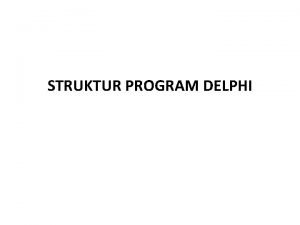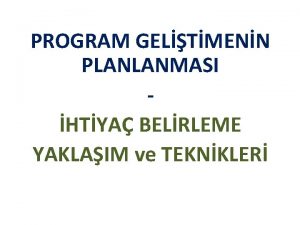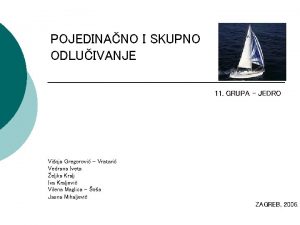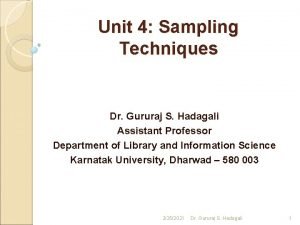Delphi Method Dr Gururaj S Hadagali Assistant Professor









- Slides: 9

Delphi Method Dr. Gururaj S. Hadagali Assistant Professor Department of Library and Information Science Karnatak University, Dharwad – 580 003 3/2/2021 Dr. Gururaj S. Hadagali 1

Introduction �Delphi method is comprised of a group of modified survey procedures. It is designed for use in refining judgmental data collected from a panel of selected experts. �This technique was developed in the early 1950 s by the Rand Corporation to predict future developments related to national defense. �Delphi is a systematic approach to the generation of consensus opinions among a group of carefully selected anonymous respondents. 3/2/2021 Dr. Gururaj S. Hadagali 2

�Olaf Helmer, was instrumental in devising Delphi method. According to him Delphi method is ‘a carefully designed program of sequential individual interrogations (best conducted by questionnaires) interspersed with information and opinion feedback. �Panel participants are often selected because of their knowledge of the subject under investigation; however, the experts need not necessarily be members of the same discipline or possess similar backgrounds. 3/2/2021 Dr. Gururaj S. Hadagali 3

�The users of Delphi method assume that it prevents the opinions of experts from being contaminated by: �Strong personalities of the dominant respondents; �The bandwagon effect, and �Public opinion 3/2/2021 Dr. Gururaj S. Hadagali 4

Steps in Delphi Study �The basic Delphi procedure has often been tailored to meet unique needs of a variety of disciplines and purposes. The following are the steps generally utilized in Delphi studies: �Step 1: Select a panel of experts who are capable of providing insightful opinions concerning the pertinent topic. �Explain the rationale of the study to the experts and request their anonymous participation as independent panel members. 3/2/2021 Dr. Gururaj S. Hadagali 5

�Step 2: ask each participant to compile a list of value judgments, predictions, or opinions about the assigned issue or topic (in some cases, participants may be asked to respond to a list of statements preselected by the investigator). �Step 3: Collect the initial responses and incorporates them into a questionnaire for use in a first-round interaction. �Then, request that the same panel members rank the recorded statements according to independently perceived orders of priority or importance. 3/2/2021 Dr. Gururaj S. Hadagali 6

�Step 4: Upon receipt of all first-round questionnaires from participants, analyse the data statistically (e. g. determine the median and inter-quartile range of responses). �Subsequently, rearrange the statements according to the new, revised ranking. �List them in another questionnaire to be used in the second round and provide respondents with a statistical summary of the ranked statements. 3/2/2021 Dr. Gururaj S. Hadagali 7

�Step 5: Submit the second round instrument to the same panel members, asking them to reconsider their second responses, given the statistical summary of that round. �Step 6: repeat step 5 for the third round questionnaire interaction. �Respondents whose opinions still fall outside the inter -quartile range for the third round are asked to explain why their feelings did not change. 3/2/2021 Dr. Gururaj S. Hadagali 8

�At the conclusion of the third round (or, whose consensus opinions have been obtained), the investigator prepares a final draft of the ranked statements, revealing how much opinion change has occurred. �The consensus opinions are summarized, together with other pertinent comments elicited from participants 3/2/2021 Dr. Gururaj S. Hadagali 9















